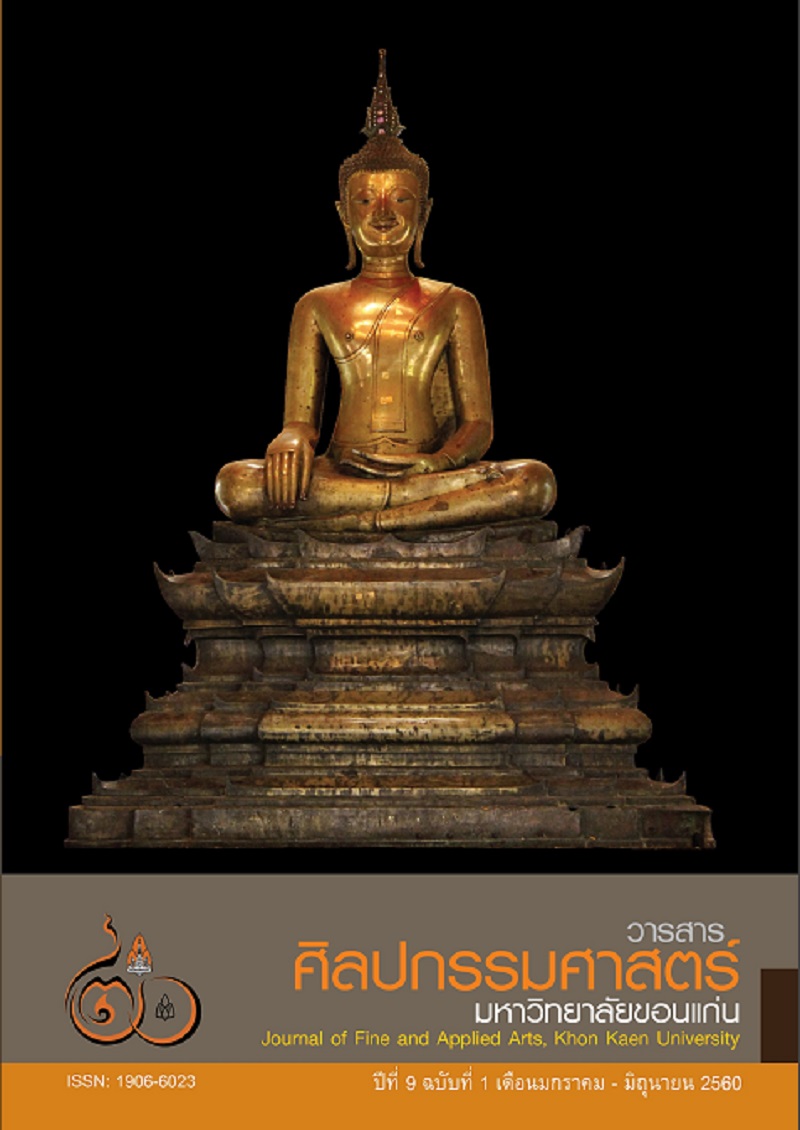กรรมวิธีการสร้างซออู้ จากมะพร้าวซอของจังหวัดสมุทรสงคราม กรณีศึกษา ช่างประสิทธิ์ ทัศนากร The method for building Saw –U from Samutsongkhram’s coconut shell The case study of Prasit Tassanakron
Main Article Content
Abstract
งานวิจัยเรื่อง กรรมวิธีการสร้างซออู้จากมะพร้าวซอของจังหวัดสมุทรสงคราม กรณีศึกษาช่างประสิทธิ์ ทัศนากร โดยมีวัตถุประสงค์เพื่อศึกษาภูมิปัญญาท้องถิ่นการปลูกมะพร้าวซอ และศึกษากรรมวิธีการสร้างซออู้ จากมะพร้าวซอของจังหวัดสมุทรสงคราม กรณีศึกษาช่างประสิทธิ์ ทัศนากร โดยใช้วิธีการเก็บข้อมูลภาคสนามลงมือปฏิบัติในฐานะเป็นลูกมือช่างเป็นเวลา 2 เดือน
ผลการศึกษาพบว่าช่างประสิทธิ์ ทัศนากร ให้ความสำคัญในการปลูกมะพร้าวซอโดยใช้ภูมิปัญญาในการปลูกมะพร้าวซอของจังหวัดสมุทรสงครามเพื่อประดิษฐ์เป็นซออู้ของไทย ขั้นตอนการปลูกมะพร้าวซอตั้งแต่การเตรียมพันธุ์มะพร้าวซอ การเตรียมพื้นที่ในการปลูก การดูแลบำรุงต้นมะพร้าวซอ การเก็บเกี่ยวผลมะพร้าวซอทั้งยังอนุรักษ์รูปทรงและสัดส่วนของซออู้ให้มีคุณภาพและได้มาตรฐานตามแบบสัดส่วน และได้พัฒนารูปทรงและสัด ส่วนให้เป็นมาตรฐานในแบบของตน ใช้เวลาในการสร้างซออู้ 1 คัน เป็นเวลา 2 เดือน
ช่างประสิทธิ์ ทัศนากร ให้ความสําคัญในกรรมวิธีการสร้างทุกขั้นตอน กรรมวิธีการสร้างซออู้ มีทั้งหมด 7 ขั้นตอน ดังนี้ 1.การคัดเลือกกะโหลกมะพร้าวที่ใช้ทำซออู้ 2.การขัดกะโหลกซออู้ 3.การแกะลายกะโหลกซออู้ 4.พันธุ์ไม้ที่ใช้ในการสร้างซออู้ 5.การจัดหาวัสดุอุปกรณ์ที่ใช้ทำซออู้ 6.ขั้นตอนและกรรมวิธีในการสร้างซออู้ 7.ปัญหาและอุปสรรคต่างๆ ในการสร้างซออู้ กรรมวิธีการสร้างซออู้ของช่างประสิทธิ์ อาศัยความละเอียด กับความประณีตของช่าง ผนวกกับความเอาใจใส่และความตั้งใจในการทำงานของช่าง มีความพิถีพิถันในทุกขั้นตอน ตั้งแต่การคัดเลือกพันธุ์ไม้ที่นำมาทำซออู้ ได้แก่ ไม้ชิงชัน ไม้พยุง ไม้นางพญางิ้วดำ ไม้มะเกลือ ไม้ดำดง ไม้มะริด การเลือกใช้วัสดุในการสร้างซออู้ กะลามะพร้าวซอ การขัดตกแต่งกะลามะพร้าว การคัดเลือกกะโหลกมะพร้าว ลวดลายของกะโหลกซออู้ พันธุ์ไม้ในการสร้างซออู้ ผลทําให้คุณภาพเสียงซออู้คมชัด นุ่มนวล ดังกังวาน อันเกิดมาจากประสบการณ์ความรู้ทางด้านดนตรีไทยและด้านงานช่าง จึงทําให้ซออู้ทุกคันที่สร้างโดยช่างประสิทธิ์ ทัศนากร เป็นที่ยอมรับว่ามีคุณภาพเสียงดีเยี่ยมและเป็นงานกลึงที่ประณีต งดงาม จนเป็นที่ยอมรับในกลุ่มนักดนตรีไทยโดยทั่วไป
The study is entitled ‘A production of SAW-U: a case study of Prasit Tassanakron, the SAW-U maker.’ It aims to study a process of SAW-U production in Samut Songkram province by Prasit Tassanakron. The field study is used to collect the information by being an assistant of the SAW-U maker for two months.
The study found that Prasit Tassanakron has paid close attention to the very first step of growing a coconut tree to produce SAW-U in Samut Songkram. Starting with a selecting of coconut tree seeds, preparing a planting field, taking care of the tree, and harvesting the coconut. He has focused on preserving the shape and proportion of Saw-U to keep a high production standard in his owned unique style. One SAW-U can take about 2 months in a production.
Prasit Tassanakron pays close attention to every detail of the production in all 7 areas, including 1) a selection of coconut shell, 2) polishing, 3) crafting, 4) a selection of wood, 5) a selection of all materials, 6) a production of SAW-U, 7) issues concerning a production. The process requires delicate skills of the craftsmen and full attention to every steps of production. First, the wood has carefully been selected from a variety of trees, for example rosewood, black wood, and ebony. The selection of all materials as well as the crafting and pattern of the coconut shell impact the sound quality of SAW-U, to make it clear, smooth and resonant. It is a real art piece that combines understanding in the Thai traditional music with expertise in handicrafts. SAW-U made by Prasit Tassanakron is well known among Thai musician.
Article Details
Content and information in articles published in the Journal of Fine and Applied Arts of Khon Kaen University is regarded as the opinion and sole responsibility of the author(s) directly; therefore, editors are not obliged to agree to or share any responsibility with regard to the content and information that appears within these articles.
All articles, information, content, image, etc. that have been published in the Journal of Fine and Applied Arts of Khon Kaen University is the copyright of the Journal of Fine and Appllied Arts of Khon Kaen University. Any person or organization who wishes to distribute all or parts of the articles for further dissemination or other usage must first receive permission from the Journal of Fine and Applied Arts of Khon Kaen University before proceeding to do so.


